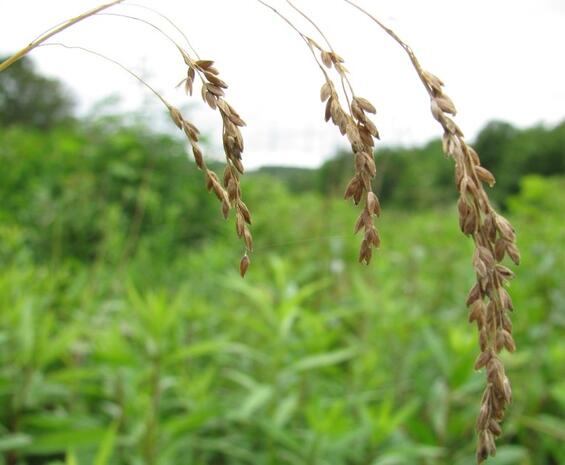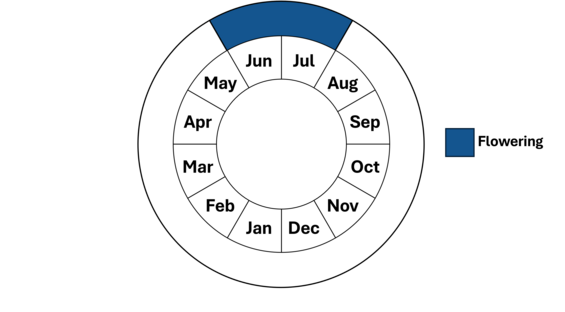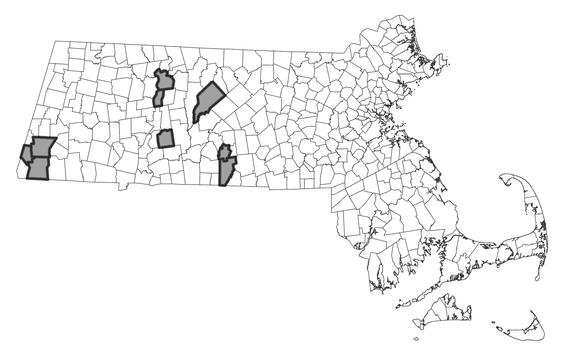- Scientific name: Poa saltuensis ssp. languida
- Species of Greatest Conservation Need (MA State Wildlife Action Plan)
- Endangered (MA Endangered Species Act)
Description

Drooping speargrass (Poa saltuensis)
Drooping speargrass (Poa saltuensis ssp. languida) is a slender, graceful perennial grass (family Poaceae), of rich, rocky woodlands and openings. Reaching 30-100 cm (12-39 in) in height, the culms (flowering stems) of this grass are weak, and the flowering panicle is loose and nodding, with slender arching branches. The scientific name of drooping speargrass is appropriate; Poa is Greek for grass or fodder and languida is Latin for weak, in reference to the drooping flower panicles.
Drooping speargrass grows in loose tufts from a fibrous root base. The leaves are bluish green, soft, and narrow, 2-5 mm wide and up to 10 cm (4 in) long. The leaf sheaths are nearly glabrous, closed for at least one-third their length, compressed, and shorter than the internodes. At the junction of the sheath and leaf blade is a collar-like structure, the ligule. In this species it is mostly smooth, blunt, or slightly rounded toward the tip, 2.4- 4 mm long. The drooping flower panicle is 5-10 cm (~2-4 in) long. The branches of the panicle are usually arranged in pairs or groups of three at each node and bear a few spikelets toward their tips. The spikelets are somewhat flattened, two to four flowered, and 3-4 mm long. The tiny grain is yellowish and lance-ellipsoid, 1.5-2 mm long.
In grasses, the inflorescence (a spike or panicle) consists of numerous spikelets, the basic flowering unit. Each spikelet is subtended by two basal glumes. Individual florets comprise the lemma (lower or outer bract), the palea (upper or inner bract), and the reproductive structures (e.g., ovary, anthers). Drooping speargrass has a first glume that is narrow, slightly wider toward the base, and pointed toward the tip, 1.7-2.6 mm long. The second glume is slightly broader and lance-elliptic, 2.1-2.9 mm. The rest of the spikelet is made up of 2 to 4 florets arranged in tight alternating rows. The lemmas of drooping speargrass are 2-3 mm long, firm, distinctly nerved, and smooth except for a tuft of webbing at the base. The lemmas have rounded to broadly acute tips that form angles, generally greater than 45º. The anthers are 0.4-0.9 mm long. Drooping speargrass flowers in late spring to early summer; mature florets are present into July. Plants begin to senesce by midsummer.
Drooping speargrass is similar in appearance to woodland speargrass (Poa saltuensis ssp. saltuensis) and may be differentiated by the shape of the lemma apex and the length of the flower anthers. As described above, the lemma of drooping speargrass has a broad apical angle. A scarious tip is usually absent, or if present it does not exceed 0.25 mm in length. Whereas the lemma of woodland speargrass is acute at the apex, the keel and lateral margins of the lemma form an apical angle generally less than 45º. The apex has a prominent scarious tip, 0.25-0.5 mm long. woodland speargrass also has longer anthers, 0.9-1.5 mm long.
Life cycle and behavior
This is a perennial species.

Population status
Drooping seagrass is listed as endangered under the Massachusetts Endangered Species Act. The Natural Heritage & Endangered Species Program has 15 records from 5 counties: Berkshire, Franklin, Hampshire, Hampden, and Worcester. Seven of these records have been observed within the last 25 years.
Distribution and abundance
Drooping speargrass is found from Massachusetts and Vermont west to Minnesota, and south to Iowa, Illinois, Kentucky, and North Carolina. It is rare throughout much of its range.

Distribution in Massachusetts. 1999-2024. Based on records in the Natural Heritage Database.
Habitat
Drooping speargrass inhabits dry, rocky fertile soils derived from base-rich bedrock such as basalt, marble, or limestone. It typically occurs on slopes and ridge crests, within deciduous forests and woodlands characterized by various oaks (Quercus spp.), hickories (Carya spp.), hop hornbeam (Ostrya virginiana), white ash (Fraxinus americana), sugar maple (Acer saccharum), and basswood (Tilia americana). Flowering dogwood (Cornus florida), beaked hazelnut (Corylus cornuta), and mapleleaf viburnum (Viburnum acerifolium) may be scattered in the understory. Herbaceous associates include thread-leaved sedge (Carex eburnea), bashful club-sedge (Scirpus verecundus), woodland-oatgrass (Danthonia compressa), and bluestem goldenrod (Solidago caesia). Rare associates include yellow oak (Quercus muhlenbergii; threatened), shining wedgegrass (Sphenopholis nitida; threatened), handsome sedge (Carex formosa; threatened), and devil’s-bit (Chamaelirium luteum; endangered).
Healthy habitats are vital for supporting native wildlife and plants. Explore habitats and learn about conservation and restoration in Massachusetts.
Threats
Habitats on relatively flat terrain are vulnerable to development and intensive land uses. Activities such as off-road vehicle use or over-grazing may compact or disrupt the shallow rocky soils required for germination and growth of drooping speargrass. At certain sites, lack of small-scale disturbance such as wind-throw or fire may limit the ability of drooping speargrass to compete with other species. Habitats are susceptible to invasions of exotic plant species, which can out-compete native plants for nutrients and light, excluding them over time. Exotic species that can invade rich rocky sites include Japanese barberry (Berberis thunbergii), Asiatic bittersweet (Celastrus orbiculatus), morrow honeysuckle (Lonicera morrowii), swallowworts (Cynanchum spp.), and Canada bluegrass (Poa compressa).
Conservation
As with many rare species, the management needs of drooping speargrass are not fully known. Research and monitoring aimed at understanding the biology and population dynamics of drooping speargrass are warranted. Investigations of natural community characteristics, land use history, and soil fertility gradients are needed to determine the limiting factors at each site and active management needs. Drooping speargrass habitat should be monitored for exotic invasive species. If exotic plants are invading drooping speargrass habitat, a plan for control should be constructed. All active management within the habitat of a rare plant population (including invasive species removal) is subject to review under the Massachusetts Endangered Species Act and should be planned in close consultation with the MassWildlife’s Natural Heritage & Endangered Species Program.
References
Gleason, H. A., and A. Cronquist. 1991. Manual of Vascular Plants of Northeastern United States and Adjacent Canada, 2nd edition. The New York Botanical Garden, Bronx, NY.
Haines, A. 2011. Flora Novae Angliae – a Manual for the Identification of Native and Naturalized Higher Vascular Plants of New England. New England Wildflower Society, Yale Univ. Press, New Haven, CT.
Contact
| Date published: | May 5, 2025 |
|---|